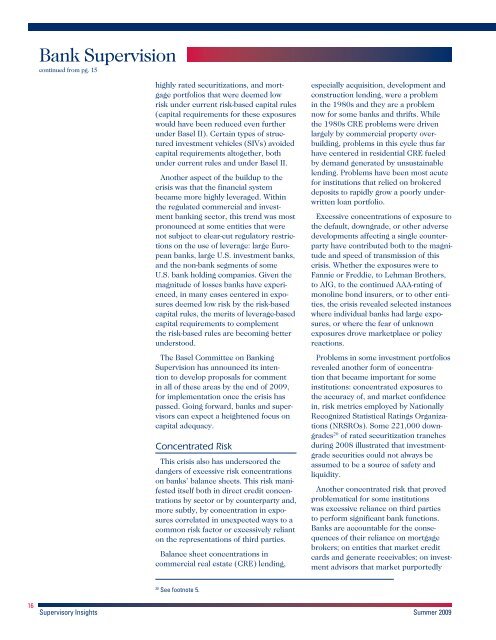FDIC Supervisory Insights Summer 2009
FDIC Supervisory Insights Summer 2009
FDIC Supervisory Insights Summer 2009
You also want an ePaper? Increase the reach of your titles
YUMPU automatically turns print PDFs into web optimized ePapers that Google loves.
Bank Supervision<br />
continued from pg. 15<br />
highly rated securitizations, and mortgage<br />
portfolios that were deemed low<br />
risk under current risk-based capital rules<br />
(capital requirements for these exposures<br />
would have been reduced even further<br />
under Basel II). Certain types of structured<br />
investment vehicles (SIVs) avoided<br />
capital requirements altogether, both<br />
under current rules and under Basel II.<br />
Another aspect of the buildup to the<br />
crisis was that the financial system<br />
became more highly leveraged. Within<br />
the regulated commercial and investment<br />
banking sector, this trend was most<br />
pronounced at some entities that were<br />
not subject to clear-cut regulatory restrictions<br />
on the use of leverage: large European<br />
banks, large U.S. investment banks,<br />
and the non-bank segments of some<br />
U.S. bank holding companies. Given the<br />
magnitude of losses banks have experienced,<br />
in many cases centered in exposures<br />
deemed low risk by the risk-based<br />
capital rules, the merits of leverage-based<br />
capital requirements to complement<br />
the risk-based rules are becoming better<br />
understood.<br />
The Basel Committee on Banking<br />
Supervision has announced its intention<br />
to develop proposals for comment<br />
in all of these areas by the end of <strong>2009</strong>,<br />
for implementation once the crisis has<br />
passed. Going forward, banks and supervisors<br />
can expect a heightened focus on<br />
capital adequacy.<br />
Concentrated Risk<br />
This crisis also has underscored the<br />
dangers of excessive risk concentrations<br />
on banks’ balance sheets. This risk manifested<br />
itself both in direct credit concentrations<br />
by sector or by counterparty and,<br />
more subtly, by concentration in exposures<br />
correlated in unexpected ways to a<br />
common risk factor or excessively reliant<br />
on the representations of third parties.<br />
Balance sheet concentrations in<br />
commercial real estate (CRE) lending,<br />
20 See footnote 5.<br />
especially acquisition, development and<br />
construction lending, were a problem<br />
in the 1980s and they are a problem<br />
now for some banks and thrifts. While<br />
the 1980s CRE problems were driven<br />
largely by commercial property overbuilding,<br />
problems in this cycle thus far<br />
have centered in residential CRE fueled<br />
by demand generated by unsustainable<br />
lending. Problems have been most acute<br />
for institutions that relied on brokered<br />
deposits to rapidly grow a poorly underwritten<br />
loan portfolio.<br />
Excessive concentrations of exposure to<br />
the default, downgrade, or other adverse<br />
developments affecting a single counterparty<br />
have contributed both to the magnitude<br />
and speed of transmission of this<br />
crisis. Whether the exposures were to<br />
Fannie or Freddie, to Lehman Brothers,<br />
to AIG, to the continued AAA-rating of<br />
monoline bond insurers, or to other entities,<br />
the crisis revealed selected instances<br />
where individual banks had large exposures,<br />
or where the fear of unknown<br />
exposures drove marketplace or policy<br />
reactions.<br />
Problems in some investment portfolios<br />
revealed another form of concentration<br />
that became important for some<br />
institutions: concentrated exposures to<br />
the accuracy of, and market confidence<br />
in, risk metrics employed by Nationally<br />
Recognized Statistical Ratings Organizations<br />
(NRSROs). Some 221,000 downgrades<br />
20 of rated securitization tranches<br />
during 2008 illustrated that investmentgrade<br />
securities could not always be<br />
assumed to be a source of safety and<br />
liquidity.<br />
Another concentrated risk that proved<br />
problematical for some institutions<br />
was excessive reliance on third parties<br />
to perform significant bank functions.<br />
Banks are accountable for the consequences<br />
of their reliance on mortgage<br />
brokers; on entities that market credit<br />
cards and generate receivables; on investment<br />
advisors that market purportedly<br />
16 <strong>Supervisory</strong> <strong>Insights</strong> <strong>Summer</strong> <strong>2009</strong>

















